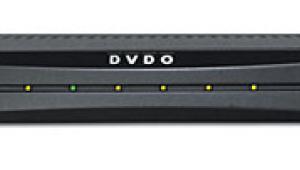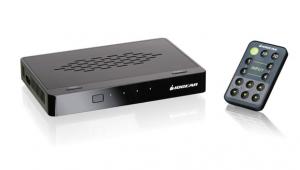Key Digital Systems HD Hanna Video Processor Page 2
Other onscreen displays and menus let you select between ten different output resolutions: 720x480 interlaced or progressive, 1280x720p, 1920x1080i/30, 1920x1080p/24, 1920x1080p/60, 1280x768p, 1366x768p, 1400x1050p, and 1920x540p. The real puzzler is 1920x1080p/24, which will result in considerable flicker on certain types of displays, such as CRTs (unless the display itself is designed to double or triple the frame rate by flashing each frame two or three times—an unlikely feature in a CRT).
You can also fine-tune horizontal and vertical picture size for any of the aspect ratios, which are native (4:3 or 16:9), horizontal zoom (anamorphic), vertical zoom, letterbox (16:9 on a 4:3 display), and pillarbox (4:3 on a 16:9 display).
There are two Image Quality options for the HD and SD outputs, but I am not sure what they do as I couldn't see much difference in image quality with them on or off. In the Audio menu, you can select between AC3 and PCM digital audio output from the digital TV tuner and enable the main analog and digital audio outputs simultaneously or separately. (Newcomers may be puzzled by the AC3 designation used in the Audio menu. It's simply the now little-used name of the coding format used for Dolby Digital recording.)
A FireWire OSD lets you remotely operate compatible devices, such as my studio's JVC HM-DH30000U D-VHS deck. Once I connected a FireWire cable between the JVC and HD Hanna, it was recognized immediately in the menu, and I could set it to perform up to three timed recordings of content from HD Hanna's digital TV tuner.
Seven somewhat useful test patterns round out the menu selections: vertical grayscale ramp, color bars, horizontal grayscale ramp, crosshatch pattern, full-screen white field, and full-screen black field.
Performance
I connected my Panasonic RP56 DVD player to HD Hanna's composite, S-video, and component inputs. The output of HD Hanna was set to 1280x720/60 to drive my Princeton AF3.0HD CRT monitor in both RGB and YPbPr formats, and the DVI-D output from HD Hanna was connected to a Dell W1900 LCD TV. The downconverted SD connections (composite and S-video) also went to the Princeton monitor.
I also hooked up my rooftop antenna to the Antenna A input for digital TV reception, while analog cable signals were routed to the Antenna B jack. I performed a channel scan (see above), and it took several tries for HD Hanna to successfully find all the available digital channels in this area.
Once the channel scans were completed, I could go into the menus and select the channels I wanted to keep and those I didn't. Oddly, KYW's digital TV signal on 3-1 showed up in the channel-scan list, but it could not be tuned directly from the remote after the first two times I executed a channel scan.
I also discovered that changing digital channels is a slow process. HD Hanna must first tune to the digital channel, decode the MPEG data, and determine the display format (480i, 480p, 720p, or 1080i). Then it either scales the signal (if 480i), or passes it directly through to your TV (if 480p, 720p, or 1080i).
This causes the TV to lose picture sync for a moment, which is very distracting. Since HD Hanna is designed to scale only interlaced standard-definition video, there's not much you can do about it. I also noticed HD Hanna would occasionally lose sync and reset even after a strong DTV channel was tuned in. In contrast, all current-model set-top boxes allow you to format-convert all received signals to one standard output resolution, which makes tuning around a breeze. By the way, HD Hanna format-converts all analog TV channels to the output resolution and picture aspect ratio you've selected. The DVI output is also active for digital TV channels at their native resolution.
On to the scaler. I didn't make this part of the test too complicated, relying on the test patterns from Video Essentials and Silicon Optix' HQV Benchmark test DVDs. KDS' Clear Matrix Pro image processing is supposed to be top-notch, but I had mixed results with it.
To start with, HD Hanna did a very good job decoding and deinterlacing video from composite, S-video, and component 480i signals. The Zone Plate pattern was clear of color moiré at 300 and 400 lines and plenty of image detail was seen in those two patterns.
The rotating bar from the HQV DVD and the waving flag from VE were remarkably smooth and free of any scan-line artifacts. This level of performance is equal to the Faroudja processing in my Panasonic RP56 DVD player.
Where HD Hanna ran into problems was with the film-detail sequence from the HQV DVD. This is a short clip of a race car passing in front of a grandstand. The clip is a 3:2 film-to-video conversion, and HD Hanna was unable to detect the 3:2 sequencing, resulting in lots of moiré in the grandstand.
This clip only worked cleanly with HD Hanna's S-video and component inputs, where it detected and compensated for the 3:2 sequence in less than half a second. As a result, I can't recommend HD Hanna's composite video processing—use it only as a last resort.
I also found I had to make more than a few adjustments to boost brightness, contrast, color saturation, and tint in the HD Hanna menu with any of the three signals from the Panasonic DVD player. Use Video Essentials or the Avia test DVD to carefully calibrate your HD display in 480p mode and then HD Hanna in 480p mode to make sure their settings agree before you finish HD Hanna's 720p and 1080i image calibrations.
Conclusions
HD Hanna is an interesting product and could be a useful one in your home theater, doubling as a video scaler/processor and TV tuner. The tuner section needs to lock onto the signal more quickly; the momentary loss of picture and sync when changing between some digital TV channels is very distracting.
Alas, at $2495, HD Hanna's price is high, given that you can pick up a fourth-generation ATSC/NTSC set-top receiver that tunes far more rapidly for under $300 and a good video scaler such as DVDO's iScan HD+ for less than $1500. (The latter also has pass-through functions and lets you select from several analog and digital video inputs with audio-follow capability.)
Still, picture quality is quite good, certainly as good as DVDO's iScan products. The deinterlacing performance with S-video and component connections is top notch, even with fast motion sequences. And the 3:2 motion compensation is also a strong point of this product, as long as you aren't feeding HD Hanna composite video signals.
Highs and Lows
Highs
Excellent deinterlacing of component and S-Video sources
Deinterlaces 1080i/30 to 1080p/60
Lows
Composite deinterlacing is marginal
Labels on remote control can be confusing
Review System
Panasonic DVD-RP56 DVD Player
Princeton AF3.0HD reference monitor
- Log in or register to post comments



























































